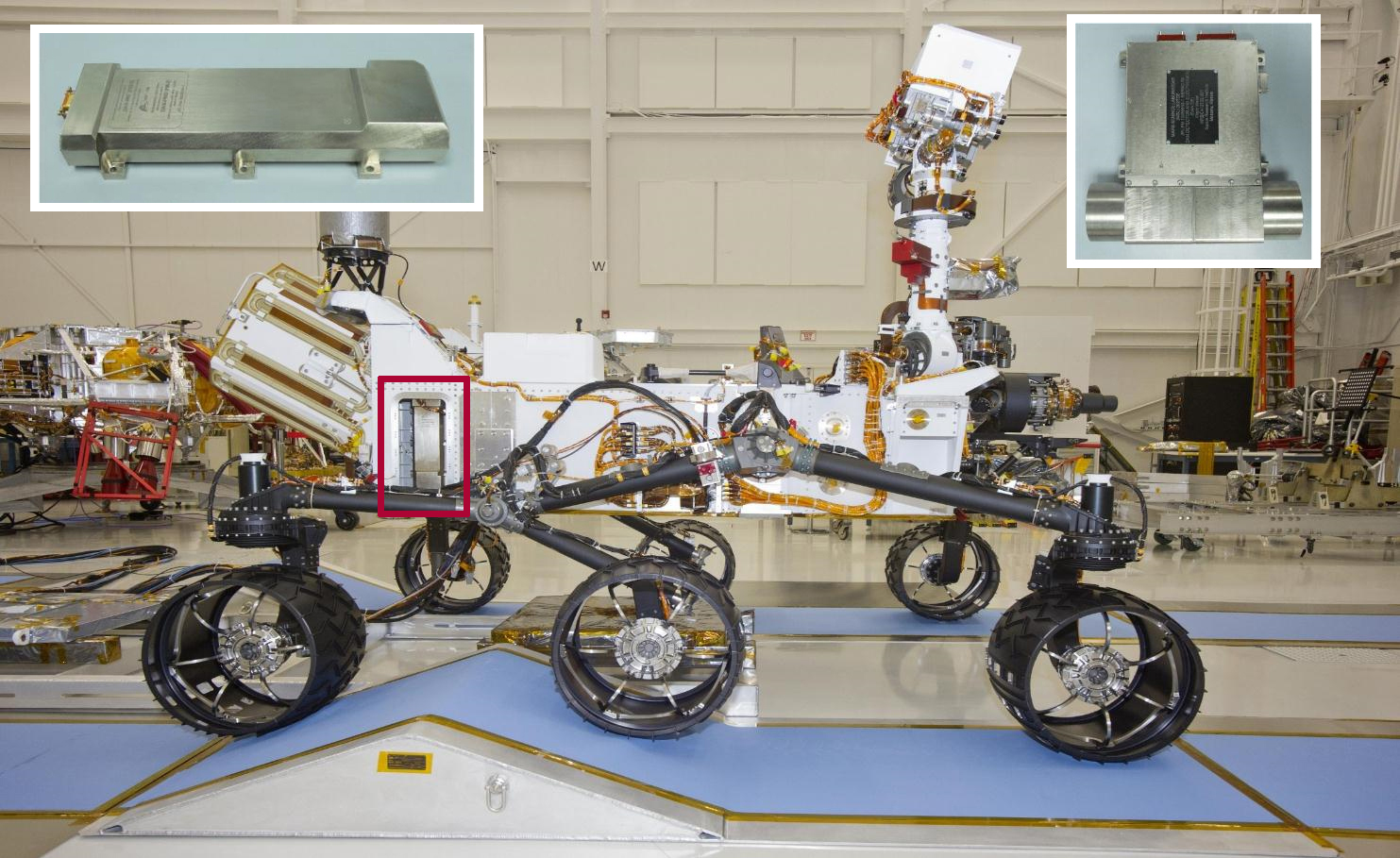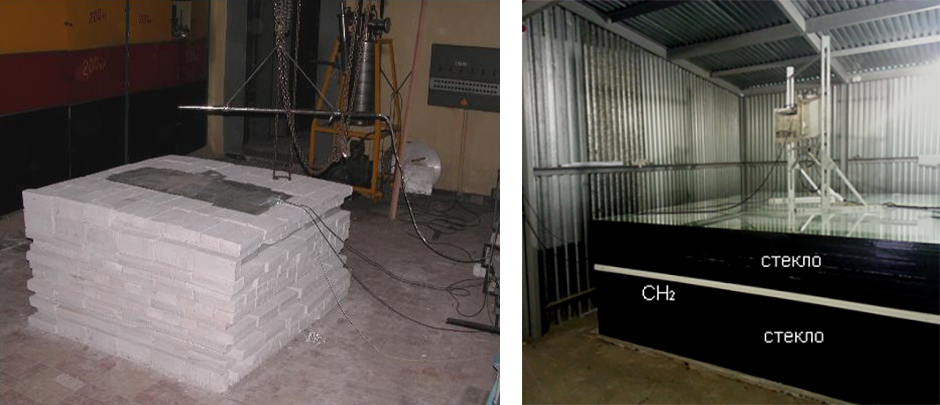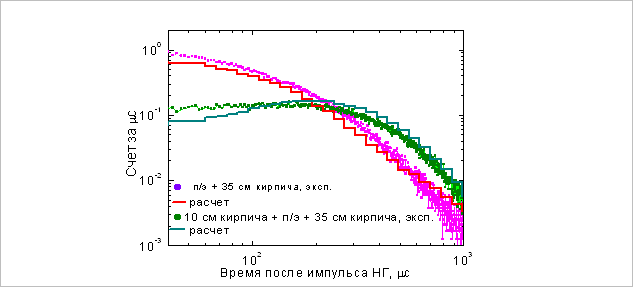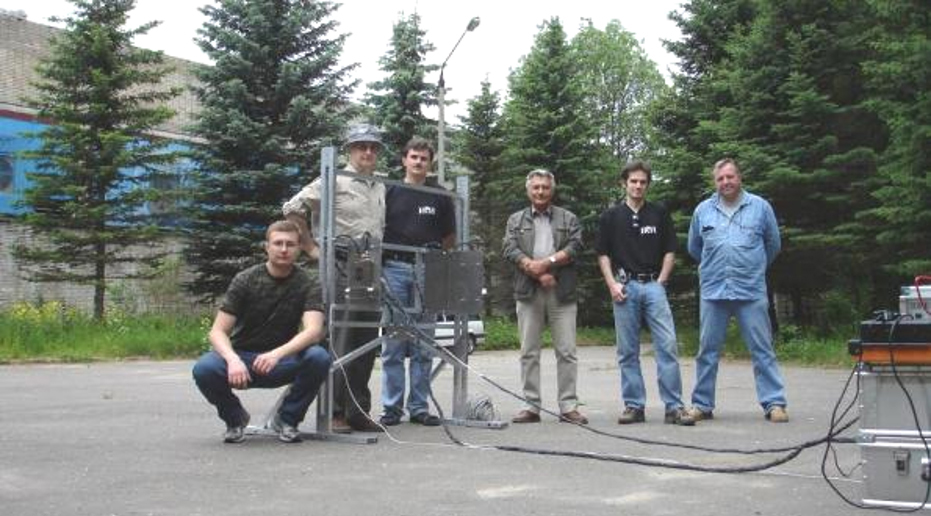Device developed and tested in collaboration with JINR has been working on Mars for ten years
News, 23 August 2022
This year, it is the 10th anniversary of the launch of the DAN science instrument of the Space Research Institute of the RAS (IKI RAS), created and tested with the participation of two laboratories of the Joint Institute for Nuclear Research, on board the Curiosity rover. The device was designed to determine the presence of water in the Martian Gale crater.
On 9 August 2012, Curiosity rover of NASA’s Mars Science Laboratory descended to the surface of Mars and began its work, which continues to this day. The main scientific goals of the Mars Science Laboratory mission are to determine whether life could have ever existed on Mars, what role water plays in this, and to study climate and geology of Mars.
 The Curiosity rover and the DAN instrument aboard it. The red frame marks the location of the DAN science instrument on the rover. Image © NASA
The Curiosity rover and the DAN instrument aboard it. The red frame marks the location of the DAN science instrument on the rover. Image © NASA
The rover carries 13 scientific instruments, one of which is the active neutron spectrometer DAN – Dynamic Albedo of Neutrons (the albedo of neutrons is the probability of their reflection as a result of multiple scattering in a medium). The instrument uses the surface neutron logging method to study the content of bound water/water ice in the top layer of the Red Planet’s soil along the rover’s path. Scientists use particularly ice because the temperature on Mars rarely exceeds 0°C and water on the planet changes from a solid to a steam as it gets hotter due to its extremely thin atmosphere and consequently very low atmospheric pressure. The Curiosity research area is limited to the Gale Crater (about 150 km across), which is located near the planet’s equator.
The Gale crater, formed by a meteorite impact, is between 3.5 and 3.8 billion years old and was once covered by a lake (when Mars’ atmosphere was several times denser). Over the years, the rover has covered a distance of 29 km. It was known from earlier data obtained by orbiting spacecraft that Mars now has the most water near its poles. The rover’s landing site was chosen to study the planet’s geological history: the crater contains rocks of both magmatic and depositional origin. Therefore, it was no surprise to scientists that there was little water in the path of the Curiosity.
As a result of about 1,500 sessions of neutron sensing of the Martian surface by the DAN experiment, the concentration of water on the surface of Gale Crater ranged from 0 to 6%, with the highest values detected in places where other rover science instrumentation detected the presence of hydrated minerals. These materials were formed there long ago, when the crater was filled with water. No evidence of living organisms has yet been found in the bottom sediments of the dried-up lake.
An important result of the DAN experiment was also the measurement of Mars’ own neutron emission. It is necessary to estimate the magnitude of the neutron component of the Martian radiation background and compare it with data from dosimeters operating on the planet’s surface and in orbit thus to prepare a potential astronaut mission to Mars.
 Neutron generator (on the left) and detector and electronics unit (on the right) of the DAS spectrometer
Neutron generator (on the left) and detector and electronics unit (on the right) of the DAS spectrometer
The unique DAN instrument was developed at IKI RAS with the participation of the Frank Laboratory of Neutron Physics and Laboratory of Radiation Biology JINR, the Federal State Unitary Enterprise Dukhov Automatics Research Institute (VNIIA), and the Mechanical Engineering Research Institute of RAS. The DAN scientific instrumentation includes a thermal and epithermal neutron control and detection unit created at IKI RAS, and a pulsed neutron generator – a fast neutron source specially modified by VNIIA for space conditions: measures were taken to improve the reliability of the generator, its minimum operating temperature was reduced from -20°С to -40°С. In order to place the device on the rover, its size and mass were significantly reduced by half compared to the production model of the generator.
The DAN spectrometer employs the neutron logging method used on Earth for oil and gas exploration. The method is based on searching for the chemical element hydrogen by means of neutron detection. “The neutron generator (NG) emits short (~1 µs) but powerful (up to 107 n) pulses of 14 MeV neutrons with a frequency of 10 Hz. Neutrons penetrate the ground around the rover to different depths (up to 1 m) and interact with the atomic nuclei of matter. In scattering reactions on nuclei, they lose energy, slow down, and part of them comes back out of the ground and is registered by the detector. The DAN device measures the time interval between the NG pulse and the moments when the albedo neutrons reach the detector (in the pauses between NG pulses). If hydrogen (water) is present in the ground, neutron deceleration is more effective and the proportion of slow neutrons in the albedo radiation increases. This leads to a change in the distribution of the arrival time of neutrons in the detector,” Gennady Timoshenko, Assistant Director for Radiation Physics of the Laboratory of Radiation Biology JINR, Doctor of Physics and Mathematics, explained the essence of the method.
In addition to hydrogen, there may be elements in the ground that have a high trapping cross-section. They absorb thermal neutrons that have already decelerated and prevent the detector from registering them. This is primarily chlorine – it is only a small amount, about one percent, but because it strongly absorbs neutrons, scientists need to take it into account. Therefore, measurements of chlorine in the soil of Mars were also carried out in parallel.
Valery Shvetsov, Director of the Laboratory of Neutron Physics JINR spoke about the role of the Joint Institute in the creation and testing of the DAN spectrometer. “The Laboratory of Neutron Physics and the Laboratory of Radiation Biology of the Joint Institute participated in the concept development, mathematical modelling of the counting characteristics of the instrument, in the development of its physical scheme, and in the preparation and calibration of sample instruments,” he said.
 On the left is the first mock up of the Martian soil with a neutron generator suspended above it; on the right is a glass and polyethylene booth
On the left is the first mock up of the Martian soil with a neutron generator suspended above it; on the right is a glass and polyethylene booth
 Comparison of calculated and experimental time distributions of events in the detector under different ground model configurations
Comparison of calculated and experimental time distributions of events in the detector under different ground model configurations
Scientists from FLNP and LRB have tested the device under both artificially simulated and field conditions. The first models of Martian soil were assembled from silicate bricks (SiO2 – 95.8%; CaO – 2.9%; Al2O3 – 0.5%), whereas ice was simulated by a layer of polyethylene. Then, a test stand representing a model of the Martian soil was created jointly by the staff of the two laboratories at LRB JINR. Polythene and window glass were taken for this purpose. The target height is up to 2 metres and the area is about 16 m2.
“Window glass is a very good material for imitating Martian soil since it contains about 70% silicon dioxide. We imitated water with polyethylene: these are hydrogen-containing layers that we placed under glass at different depths. Instruments identical to those currently operating on the spacecraft were placed on top, and the response of the instruments from the ground model of a given geometry and a given chemical composition was decoded, confirming the data that will be obtained on future spacecraft,” Valery Shvetsov explained.
The total weight of the stand was up to 30 tonnes of sheet glass. In order to register hydrogen at different depths with the device detectors, it was necessary to reassemble the stand each time, which required one or two working days and the efforts of an entire team of researchers – from 4 to 10 people.
 At the DAN field tests. From left to right: A. A. Vostrukhin (IKI), I. G. Mitrofanov (IKI), A. S. Kozyrev (IKI), G. N. Timoshenko (JINR), A. B. Sanin (ICI), and V. N. Shvetsov (JINR)
At the DAN field tests. From left to right: A. A. Vostrukhin (IKI), I. G. Mitrofanov (IKI), A. S. Kozyrev (IKI), G. N. Timoshenko (JINR), A. B. Sanin (ICI), and V. N. Shvetsov (JINR)
The description and main results of the DAN experiment were the subject of 27 articles in Russian and American scientific refereed journals. A detailed catalogue of the instrument’s scientific measurement data will be published in 2022. Further development of the neutron logging method in space is planned as part of the Russian Moon exploration programme. The DAN technology has been used to develop active neutron and gamma ray spectrometers, ADRON, which are planned to be installed on the future Luna-25 and Luna-27 automatic stations. ADRON spectrometers will measure the composition of lunar soil matter and the mass fraction of water ice in the regolith near the lunar south pole.
Since its launch, DAN has exceeded its technical capacity by several years and collected data on the hydrogen content of the crater’s soil.
The DAN instrument was delivered on board of the Curiosity rover as part of an executive agreement between NASA and Roscosmos, which has acted as the customer for the DAN science instrument, created at the Space Research Institute of the Russian Academy of Sciences. Igor Mitrofanov, Head of the Department of Nuclear Planetary Science at IKI RAS, Doctor of Physics and Mathematics, the Scientific Director of the DAN experiment.